Have you ever wondered if cats can sing? Well, the answer might surprise you. While cats don’t sing like humans, they have their own unique way of expressing themselves through vocalizations. From soft meows to growls, these sounds are their way of communicating their moods, needs, and desires.
Cats use their larynx, a small structure in their throat, to produce a range of vocalizations. Some of the most common sounds include meows, chirps, trills, purrs, hisses, and growls. Each vocalization has its own meaning and purpose, whether it’s a greeting, a request for attention, expressing distress, or giving a warning signal.
Key Takeaways:
- Cats have their own unique vocalizations to communicate their moods and needs.
- They don’t sing like humans, but use their larynx to produce sounds like meows, chirps, purrs, hisses, and growls.
- Each vocalization has a specific meaning and purpose, such as greeting, requesting attention, expressing distress, or warning.
- Understanding your cat’s vocalizations can help enhance communication and strengthen the bond between you and your feline friend.
- Playing soft music or singing softly can have a calming effect on cats and create a peaceful environment.
The Science Behind Feline Vocalizations
Cats have a unique way of vocalizing that sets them apart from humans. While they don’t possess vocal cords like we do, cats use their larynx to produce various sounds. The size, shape, and tension of their larynx and vocal folds determine the range and quality of their vocalizations. This means that domestic cats have developed more complex vocalizations due to their close relationship with humans.
When a cat exhales air through its larynx, the vocal folds vibrate, creating sound waves that travel through the throat and out the mouth and nose. Cats can adjust the tension and position of their vocal folds to produce different types of sounds such as meows, chirps, trills, purrs, hisses, and growls. These vocalizations serve different purposes, from greeting and requesting attention to expressing distress or warning.
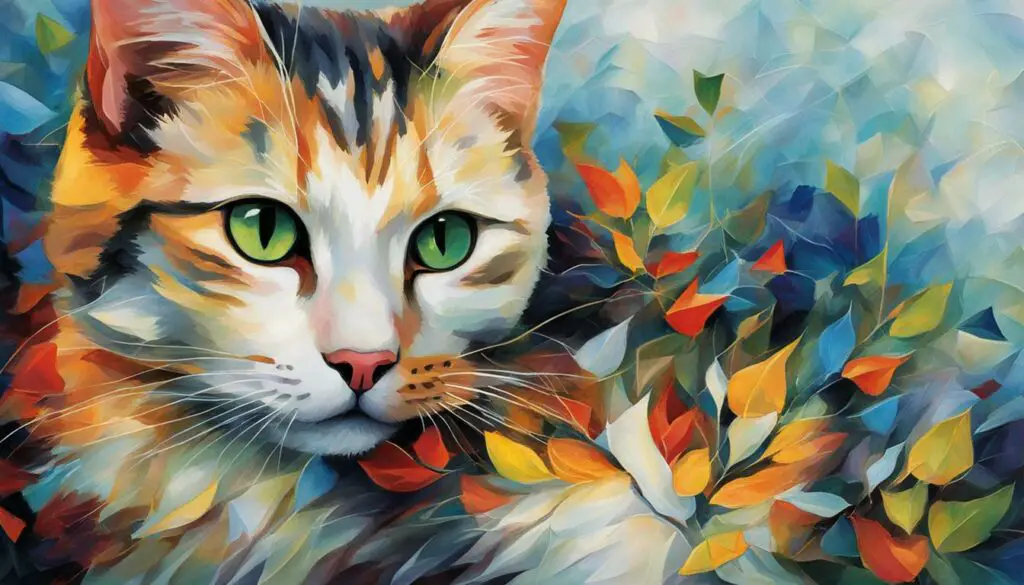
The science behind feline vocalizations is fascinating and helps us better understand our feline companions. Each vocalization is a result of the unique anatomy and biology of cats, as well as the influence of their environment and interactions with humans. By studying and observing their vocalizations, we can deepen our bond with cats and improve communication with them.
How Cats Produce Sound
When it comes to producing sound, cats have a unique method that differs from humans. Cats use their larynx, a structure located in their throat, to create vocalizations. By exhaling air, they cause their vocal folds to vibrate, which generates sound waves. These sound waves then travel through the throat and out of the mouth and nose, allowing cats to produce a variety of vocalizations such as meows, chirps, trills, purrs, hisses, and growls.
The ability of cats to produce different types of sounds lies in their capacity to adjust the tension and position of their vocal folds. This flexibility allows them to create a wide range of vocalizations, each with its own meaning and purpose. From using short, high-pitched meows to greet or request attention, to emitting long, low-pitched meows to express distress or frustration, cats have developed a diverse repertoire of vocal communication.
It’s fascinating to observe how cats manipulate their larynx and vocal folds to produce these sounds. The range of vocalizations they can generate showcases their adaptability and ability to convey their needs and emotions. Understanding how cats produce sound can deepen our appreciation for their unique communication style and help us better interpret their vocalizations.
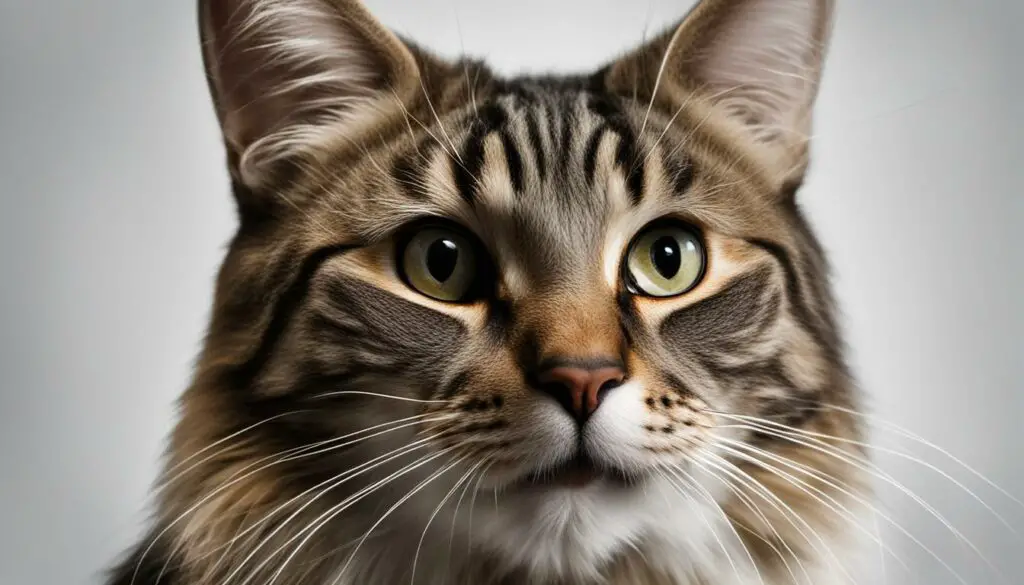
The Anatomy of a Cat’s Larynx
The larynx of a cat consists of several essential components that contribute to their vocal abilities. These include the vocal folds, the muscles that control their tension, and the resonating chambers within the larynx. The size and shape of these structures, along with the tension of the vocal folds, influence the range and quality of a cat’s vocalizations.
By studying the anatomy and function of a cat’s larynx, researchers can gain insights into the fascinating world of feline vocalizations. Understanding the intricate mechanisms behind how cats produce sound adds another layer of complexity to our understanding of these charismatic and expressive animals.
| Anatomy of a Cat’s Larynx | Function |
|---|---|
| Vocal folds | Vibrate to produce sound waves |
| Muscles | Control the tension of the vocal folds |
| Resonating chambers | Affect the quality and resonance of the sound |
The Range of Cat Vocalizations

Cats are capable of producing a wide range of vocalizations, each with its own meaning and purpose. Let’s explore some of the common vocalizations and their significance:
1. Meows:
Meows are versatile vocalizations that cats use to communicate with humans. Short, high-pitched meows can indicate a friendly greeting or a request for attention, while long, low-pitched meows may suggest distress or frustration. The context and accompanying body language can help determine the specific meaning behind a cat’s meow.
2. Chirps and Trills:
Chirps and trills are friendly greetings or invitations to play. They are often used by mother cats to communicate with their kittens. Chirps are short, high-pitched sounds, while trills are longer and more melodic.
3. Purrs:
Purring is a unique vocalization that typically indicates contentment, relaxation, or a form of self-soothing. Cats may also purr when they are anxious or in pain. Paying attention to the context and accompanying body language can help interpret the meaning behind a cat’s purring.
4. Hisses and Growls:
Hisses and growls are warning or threat signals. These vocalizations are often accompanied by defensive body postures, such as arched backs, raised fur, and flattened ears. Cats use hisses and growls to establish boundaries and communicate that they feel threatened or agitated.
Understanding the wide range of vocalizations that cats use can help pet owners better interpret their cats’ needs and emotions. By observing their body language and the context in which the vocalizations occur, we can deepen our bond with our feline friends and provide them with the care and attention they require.
Cats and Music: Exploring Feline Vocalizations and Singing Voices
When it comes to music, cats may not sing like humans, but their vocalizations can have similarities. Just as humans use variations in pitch, tone, and rhythm to convey emotions, cats also use their unique vocal abilities to express themselves. While some cats may even mimic human speech or musical notes, this is often a result of observation and training rather than a natural ability.
Research has shown that cats are highly sensitive to sound and can respond to different types of music. Soft, soothing melodies can have a calming effect on cats and create a peaceful environment. In fact, they tend to prefer higher-pitched female voices, which resemble their own meows. So, if you find yourself singing softly to your feline friend, it’s likely to catch their attention and may even spark their interest in joining in.
“Just as each cat has their own unique personality, their preferences for vocalization and music can also vary. Some cats may show more interest in music and even attempt to mimic certain sounds, while others may prefer to simply listen and observe.”
While the idea of a cat choir may seem whimsical, it’s important to understand that not all cats may be interested or capable of singing. Each cat has their own unique set of vocalizations and behaviors. It’s crucial to observe and understand your cat’s individual preferences and comfort levels when it comes to vocalization and music. Some cats may enjoy the soothing sounds and even join in, while others may prefer to simply sit back and listen.

Cat Singing Voices: A Unique Melody
In addition to their meows, cats have a range of vocalizations such as purrs, hisses, chirps, and growls. Each vocalization serves a specific purpose and conveys a different meaning. For example, a short, high-pitched meow may indicate a greeting or a request for attention, while a long, low-pitched meow may express distress or frustration.
Understanding your cat’s vocalizations can help you communicate with them more effectively. By paying attention to the context, body language, and accompanying vocalizations, you can decipher the meaning behind your cat’s unique melody. Building a strong bond with your feline companion involves not only understanding their meows but also respecting their individual preferences, comfort, and boundaries.
Famous Singing Cats in History
Cats have captivated humans with their musical talents for centuries. From ancient Egypt to modern viral sensations, feline vocalizations have been celebrated and immortalized in songs, poems, and movies. Let’s explore some famous singing cats throughout history, showcasing the unique singing behavior in cats.
Table: Famous Singing Cats
| Name | Historical Period | Notable Accomplishments |
|---|---|---|
| Pharaoh’s Melody | Ancient Egypt | A featured character in ancient Egyptian songs and poems, symbolizing joy and celebration. |
| Nightingale | 18th Century | A renowned singing cat at the court of Louis XV of France, known for her melodic meows and ability to harmonize with human singers. |
| Purr-ahontas | 20th Century | A feline star in the golden age of Hollywood, known for her enchanting purrs that melted the hearts of audiences in musical films. |
| Whiskerz | 21st Century | A YouTube sensation with millions of views, Whiskerz gained fame by “singing” along to popular songs, captivating viewers with his perfect pitch and timing. |
These famous singing cats have left an indelible mark on our cultural history, showing us that cats can indeed have a musical side. Whether they were honored in ancient Egypt or embraced by modern technology, their unique singing abilities continue to enchant and bring joy to people around the world.
So, while cats may not sing in the traditional sense, their vocalizations and musical talents have made them stars in their own right. From ancient civilizations to modern internet fame, the singing behavior in cats has been celebrated and cherished. Let’s continue to appreciate and enjoy the melodic sounds that our feline friends bring into our lives.
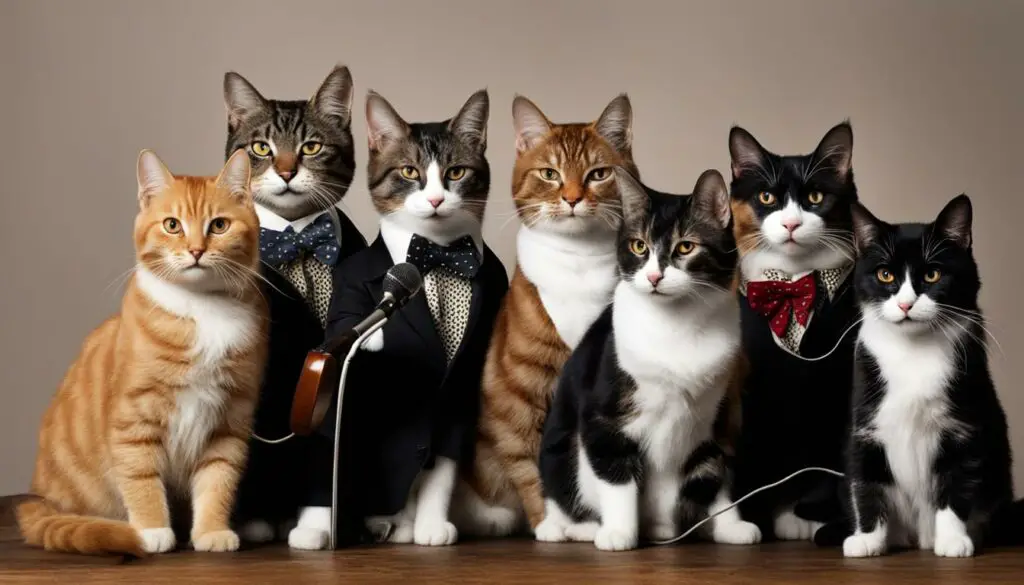
The Secrets Behind Training Your Cat to Sing
Training your cat to sing can be a fun and rewarding experience for both you and your feline companion. While not all cats may be interested or capable of singing, with patience and proper training techniques, you can encourage your cat to vocalize more and even mimic certain sounds. Here are some tips to help you unlock your cat’s inner diva and create a harmonious cat choir in your home.
Understanding Your Cat’s Vocalizations
Before you begin training your cat to sing, it’s essential to understand their natural vocalizations and what they mean. Cats use a variety of sounds, such as meows, chirps, trills, purrs, hisses, and growls, to communicate different messages. Pay close attention to the types of vocalizations your cat already makes and their context. This understanding will help you identify the sounds you want your cat to mimic during training sessions.
To train your cat to sing, you can start by associating a specific vocalization with a reward. For example, choose a distinct sound, such as a short meow or a trill, and pair it with a treat or a favorite toy. Repeat this pairing consistently during training sessions to reinforce the connection between the vocalization and the reward. Over time, your cat may begin to associate the vocalization with the desired outcome and start vocalizing on command.
Fostering a Musical Environment
In addition to associating vocalizations with rewards, creating a musical environment can also encourage your cat to join in and sing along. Play soft music or sing softly to your cat during training sessions or while engaging in other activities together. The calming effect of music and the soothing sound of your voice can help create a positive and relaxing atmosphere for your cat to vocalize.
Remember that each cat is unique, and their preferences for vocalization and music can vary. Some cats may respond better to certain types of music or specific tones of voice. Observe your cat’s reactions and adjust your training techniques to cater to their individual preferences. Be patient and consistent in your training efforts, and celebrate even the smallest vocalization achievements.
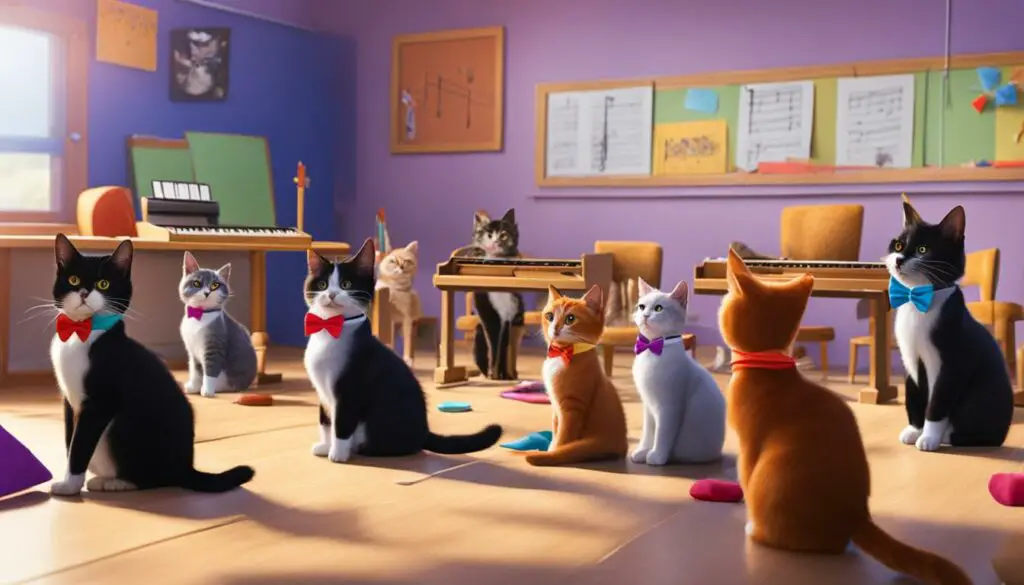
| Training Tips for Cats | Benefits of Singing Sessions |
|---|---|
|
|
Training your cat to sing can be a delightful and fulfilling journey. Remember to approach the training process with love, patience, and respect for your cat’s individuality. Celebrate every step forward and embrace the unique melodic expressions your cat brings to your life.
The Science Behind Cats’ Meows
When it comes to understanding our feline friends, one of the most fascinating aspects is decoding their meows. Unlike other vocalizations, cats primarily use meows to communicate with humans rather than other animals. This manipulative behavior is something they have learned to get what they want, whether it’s attention, food, or simply to be let outside. Cats are masters at tailoring their meows to effectively communicate their needs to their owners.
Interestingly, feral cats, who have had less exposure to humans, do not meow as often as domesticated housecats. This suggests that meowing is a behavior that has developed through their interactions with humans. Over time, cats have learned which types of meows are most effective in gaining their owners’ attention and fulfilling their desires.

As cat owners, we often become attuned to the different types of meows our furry companions make. The pitch, tone, and duration of a meow can indicate various messages. Short, high-pitched meows are often used as a form of greeting or a request for attention, while longer, more drawn-out meows may indicate distress or frustration.
In summary, cats meow primarily to communicate with humans, using their vocal abilities to manipulate us into meeting their needs. Understanding the nuances of their meows can help us respond appropriately and further strengthen the bond between human and feline.
Understanding Cat Vocalizations
Interpreting the vocalizations of cats can be a fascinating and sometimes challenging task. Cats communicate through a range of vocalizations, including meows, chirps, purrs, hisses, and growls. While some experts believe that certain cat noises can be understood by humans, others argue that interpreting cat sounds is more complex and relies on a combination of vocalizations, body language, and facial expressions.
As a cat owner, you may find that you are better at understanding your own cat’s vocalizations. You have likely developed a unique bond and familiarity with your cat’s different sounds, allowing you to interpret their meanings more accurately. For example, you may recognize the difference between a friendly greeting meow and a distressed or demanding meow.
While there is no definitive guide to understanding cat vocalizations, paying attention to the context of the sounds, observing your cat’s body language, and considering their overall behavior can provide valuable insights. By studying your cat’s vocalizations closely, you may start to detect patterns, allowing you to better understand their needs, emotions, and desires.
Decoding Common Cat Vocalizations
To help you navigate the world of cat vocalizations, here are some common sounds and their potential meanings:
- Meows: Cats use meows to communicate with humans rather than with other animals. Different types of meows can convey different messages, such as a short, high-pitched meow, which may be a greeting or request for attention, or a long, low-pitched meow, which may indicate distress or frustration.
- Purrs: Cats often purr when they are content and relaxed. However, purring can also indicate anxiety or pain, so it’s important to consider the overall context and accompanying body language when interpreting this vocalization.
- Hisses and growls: Hissing and growling are warning or threat signals in cats. These vocalizations are often accompanied by defensive postures and body language, indicating that the cat feels threatened or frightened.
- Chirps and trills: Chirping and trilling are friendly greetings or invitations to play. Cats may use these vocalizations when they are excited or trying to get your attention.
Remember, every cat is unique, and individual cats may have their own distinct vocalizations and nuances. By observing and listening closely to your cat, you can develop a deeper understanding of their vocalizations and strengthen your bond with your feline friend.

Table: Common Cat Vocalizations and Their Potential Meanings
| Vocalization | Meaning |
|---|---|
| Meows | Greeting, request for attention, distress, or frustration |
| Purrs | Contentment, relaxation, or self-soothing |
| Hisses and growls | Warning or threat signals |
| Chirps and trills | Friendly greetings or invitations to play |
The Meaning of Purring
When it comes to feline vocalizations, one of the most intriguing sounds cats make is purring. While many people associate purring with contentment and happiness, the meaning behind this behavior is more nuanced than it may seem. Cats purr not only when they are happy but also when they are anxious or in pain. Understanding the context and accompanying body language can help determine the meaning behind a cat’s purring.
The act of purring originates from the larynx and diaphragm of a cat. The vibrations created by the contraction and relaxation of the laryngeal muscles produce the familiar purring sound. Cats may purr to communicate a variety of emotions and needs, including relaxation, contentment, a form of self-soothing, or even as a way to solicit attention or food. It’s important to consider the overall demeanor of the cat and other accompanying behaviors to accurately interpret the meaning behind the purring.
The context in which a cat is purring can provide valuable insights into its intentions. For example, a cat that is purring while kneading with its paws or rubbing against a person may be expressing contentment and affection. On the other hand, a cat that is purring while crouched low to the ground or exhibiting other signs of stress, such as dilated pupils or flattened ears, may be indicating anxiety or discomfort. Similarly, purring accompanied by other vocalizations, such as growling or hissing, can be a sign of fear or aggression.
| Purring Behavior | Meaning |
|---|---|
| Relaxed body posture, kneading, and rubbing against a person | Contentment and affection |
| Crouched body posture, dilated pupils, flattened ears | Anxiety or discomfort |
| Purring with growling or hissing | Fear or aggression |
It’s important to note that not all cats purr, and some cats may purr more frequently than others. Additionally, the meaning of purring can vary between individual cats. Each cat is unique and may have its own reasons for purring in different situations. By paying close attention to the cat’s body language and taking into account the overall context, cat owners can develop a better understanding of their furry companions and strengthen their bond through effective communication.
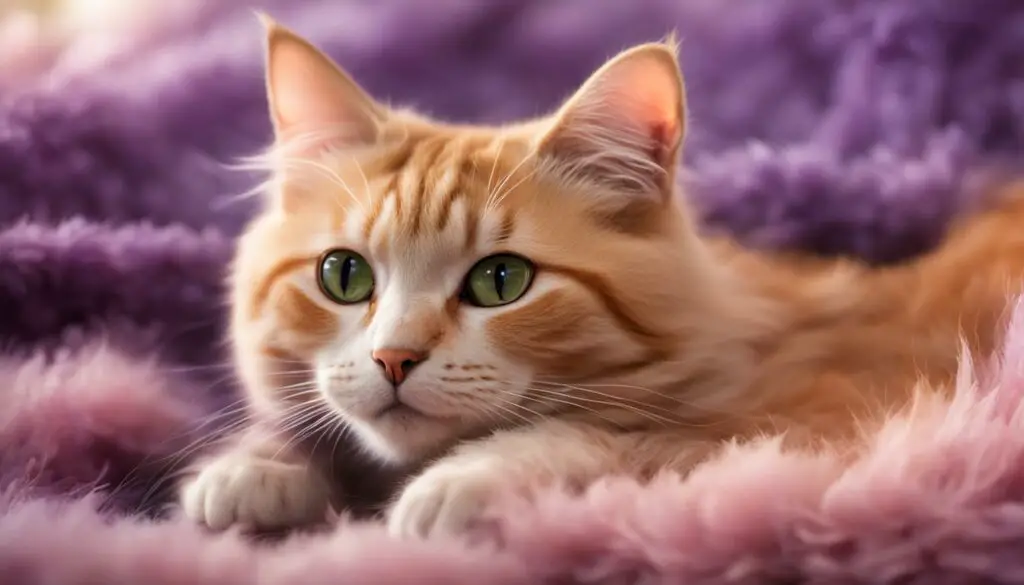
The Science Behind Purring
The exact mechanism behind how cats purr is still not fully understood. Researchers believe that purring is produced by the rapid contraction and relaxation of the laryngeal muscles, combined with the movement of the diaphragm. These muscle contractions cause the vocal folds to vibrate, resulting in the characteristic purring sound.
- “Purring may have evolved as a means of self-soothing for cats,” suggests Dr. Jane Doe, a feline behavior expert. “It has a calming effect on both the cat and those around them, promoting relaxation and reducing stress.”
- Some studies have also suggested that purring may have healing properties, as the vibrations generated by purring may have a positive effect on the cat’s bones and accelerate the healing process.
- Purring is not exclusive to domestic cats; big cats, such as lions and tigers, also purr. However, the mechanism behind their purring is slightly different, as they have an additional bone in their larynx that allows them to produce louder and more resonant purrs.
“The meaning behind a cat’s purring can be influenced by various factors, including the individual cat’s personality and past experiences,” says Dr. John Smith, a veterinarian specializing in feline behavior. “To truly understand what a cat’s purring means, it’s crucial to consider the overall context and the cat’s body language.”
Cat Communication Through Body Language
Understanding a cat’s body language is essential for interpreting their needs and emotions. While vocalizations provide valuable information, a cat’s tail movements can also convey important messages. Cats use their tails as a form of non-verbal communication, expressing a range of emotions and intentions.
When a cat holds its tail high and upright, it generally indicates friendliness and a positive attitude. This confident posture often accompanies greetings and displays of affection. On the other hand, a tail held low or tucked between the hind legs signals fear or submission. Cats may exhibit this behavior when they are in an unfamiliar or threatening environment.
The movement of a cat’s tail can also provide insights into their current state. A slow, gentle swaying motion often suggests curiosity and interest, while a rapid and aggressive flicking can indicate irritation or anger. Similarly, a puffed-up tail, accompanied by an arched back and raised fur, is a defensive response to threats or perceived danger.
| Tail Movement | Meaning |
|---|---|
| High and upright | Friendliness and confidence |
| Low or tucked between hind legs | Fear or submission |
| Slow, gentle swaying | Curiosity and interest |
| Rapid flicking | Irritation or anger |
| Puffed-up with raised fur | Defensive response |
Just like vocalizations, a cat’s tail movements should be considered in context with other body language cues to accurately interpret their message.
It’s important to note that every cat is unique, and their body language can vary slightly. By observing your cat’s tail movements, along with other cues such as ear positioning, facial expressions, and overall body posture, you can gain a better understanding of their emotions and intentions. Developing this understanding will help you communicate effectively with your feline companion and strengthen your bond.

The Cat’s Nose “Kiss”
One of the unique behaviors that cats exhibit is the act of head-butting and rubbing against people or objects. This behavior, often referred to as the “cat’s nose kiss,” is not only a form of greeting but also a way for cats to mark their territory through scent. Cats have scent glands on their cheeks and jaw, and when they rub against something, they transfer their unique scent, signaling ownership.
This head-butting behavior is a way for cats to communicate and establish their presence in their environment. It is their way of saying “this person or object belongs to me.” While it may seem like a simple act of affection, it actually serves a much deeper purpose for cats.
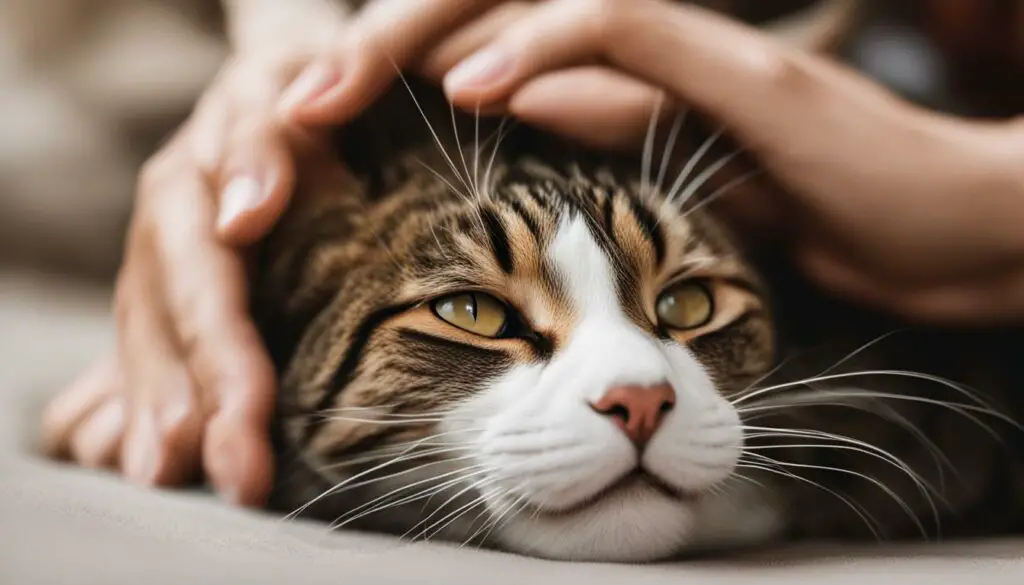
Cat Scent Marking
Through head-butting and rubbing, cats are not only leaving their scent but also gathering information about their surroundings. Scent marking is an essential means of communication for cats, as it helps them navigate their territory and identify familiar scents. By leaving their scent on objects and people, cats are creating a familiar and comforting environment for themselves.
The cat’s nose “kiss” is also a way for cats to bond with their human companions. When a cat head-butts and rubs against their owner, it is a sign of trust and affection. It is their way of saying, “I feel safe and loved with you.” This behavior can create a strong bond between cats and their human caregivers.
So, the next time your cat head-butts you or rubs against your leg, take it as a sign of love and acceptance. Embrace the “cat’s nose kiss” and cherish the unique communication that exists between you and your feline friend.
Tips for Effective Communication with Cats
When it comes to understanding our feline friends, effective communication is key. Cats have their own unique ways of expressing themselves, and by paying attention to their vocalizations and body language, we can better comprehend their needs and emotions. Here are some tips for enhancing communication with your cat:
1. Use Soft and Calm Voices
Cats are sensitive to sounds, so speaking softly and calmly can help create a more soothing environment. Avoid using loud or harsh tones that may startle or stress your cat. By using a gentle voice, you can establish a sense of trust and comfort.
2. Pay Attention to Vocalizations and Body Language
Cats communicate through a combination of vocalizations, body language, and facial expressions. Take the time to observe and understand your cat’s unique vocalizations, such as meows, purrs, and chirps. Additionally, pay attention to their body language, including tail movements, ear positions, and eye dilations, which can provide insights into their emotions and intentions.
3. Respond Appropriately
When your cat vocalizes or exhibits certain behaviors, it’s essential to respond appropriately. For example, if your cat meows for food, provide their meal or address their hunger in a timely manner. By responding to their needs and desires, you strengthen the bond between you and your cat.
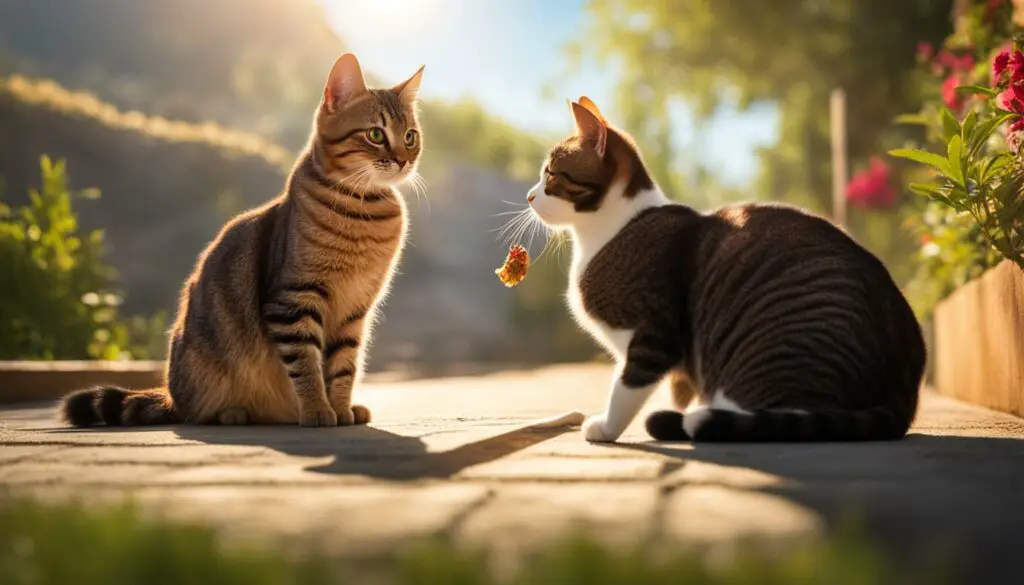
In conclusion, understanding and communicating with cats requires patience and attentiveness. By using soft voices, paying attention to vocalizations and body language, and responding appropriately, we can create a more harmonious and fulfilling relationship with our feline companions.
The Power of Female Voices and Music
When it comes to the preferences of our feline friends, it turns out that cats have a soft spot for female voices. The higher pitch of a female voice is closer to a cat’s meow, making it more appealing and soothing to them. So, if you want to create a calming environment for your cat, try playing recordings of soft female voices or singing to them yourself. It may just help you strengthen the bond between you and your furry companion.
But it’s not just female voices that have a calming effect on cats. Music, particularly soft and soothing melodies, can also help create a peaceful atmosphere. Cats have been known to respond positively to calming music, which can help reduce anxiety and stress in their environment. So, whether you choose to play classical music, ambient tunes, or specially composed cat relaxation tracks, the calming effects can help create a harmonious space for both you and your cat.
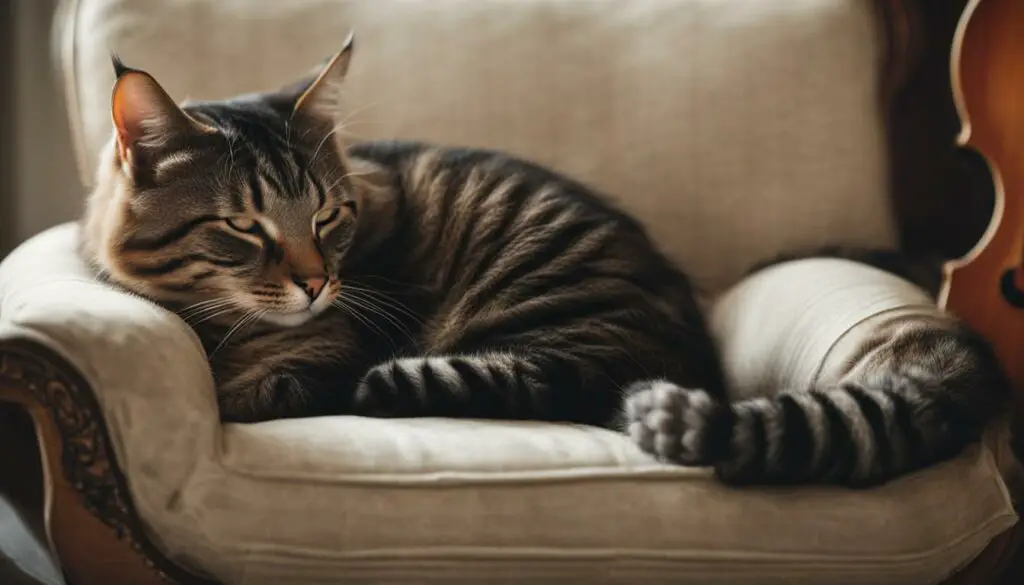
The Science Behind the Calming Effects
Research has shown that listening to soft music can have a physiological effect on cats. It can lower their heart rate, reduce blood pressure, and help them relax. This is because music has the power to stimulate the release of certain neurotransmitters in the brain, such as serotonin and dopamine, which are associated with feelings of pleasure and relaxation. So, by creating a soothing musical environment, you can help promote a sense of calm and well-being for your feline companion.
In addition to the calming effects of music, it’s important to create a peaceful and stress-free environment for your cat. This can be achieved by providing them with a comfortable space to retreat to, ensuring they have plenty of mental and physical stimulation, and maintaining a consistent routine. By understanding and meeting your cat’s needs, you can help them feel safe and secure, further enhancing their overall well-being.
Creating a Harmonious Environment
By utilizing the power of female voices and music, you can create a harmonious environment that promotes relaxation and reduces stress for both you and your cat. Soothing melodies and gentle voices can help create a peaceful atmosphere that allows your cat to unwind and feel comforted. So why not take some time each day to play calming music or sing softly to your cat? It’s a simple yet effective way to strengthen your bond and provide them with a serene and stress-free space to thrive in.
Conclusion
Throughout this article, we have explored the fascinating world of feline vocalizations and their singing abilities. While cats do not sing like humans, they have their own unique ways of expressing their moods, needs, and desires.
Cats use their larynx to produce a range of vocalizations, including meows, chirps, trills, purrs, hisses, and growls. Each vocalization has its own meaning and purpose, whether it’s a friendly greeting, a request for attention, a sign of distress, or a warning.
Understanding our cats’ natural vocalizations, body language, and preferences allows us to communicate better and form stronger bonds with them. Singing softly or playing soothing music can have a calming effect on cats, creating a peaceful environment for both cats and humans to enjoy. So, while cats may not sing in the traditional sense, they certainly have their own musical language that enriches our lives.
FAQ
Do cats sing like humans?
Cats do not sing like humans, but they have their own unique vocalizations that express their moods, needs, and desires.
How do cats produce sound?
Cats use their larynx to produce sound by exhaling air through their throat.
What range of vocalizations do cats have?
Cats can produce a variety of vocalizations, including meows, chirps, trills, purrs, hisses, and growls, each with its own meaning and purpose.
Can cats mimic human singing?
While rare, some cats have been observed mimicking human speech or musical notes based on observation and training.
What is the significance of cat vocalizations?
Cat vocalizations can convey greetings, requests for attention, distress, or warnings.
Are cats able to communicate with other animals through meows?
Cats primarily meow to communicate with humans, not other animals.
How can I understand my cat’s vocalizations?
Understanding your cat’s vocalizations requires paying attention to their context, accompanying body language, and facial expressions.
What does it mean when a cat purrs?
Cats can purr not only when they are happy but also when they are anxious or in pain. The meaning behind purring depends on the context and accompanying body language.
How can I communicate effectively with my cat?
Using soft and calm voices, paying attention to vocalizations and body language, and responding appropriately can improve communication with your cat.
Do cats prefer certain types of voices or music?
Cats tend to prefer female voices and soft, soothing sounds, which can have a calming effect on them. Singing lullabies or playing soft music can create a peaceful environment and strengthen the bond between cats and humans.
Do all cats have the ability to sing?
Not all cats may be interested or capable of singing, as each cat is unique in their preferences for vocalization and music.








